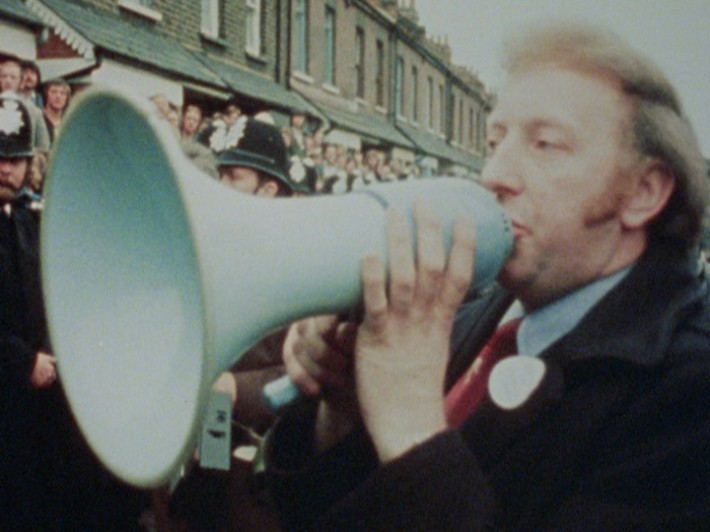BFI InView – A New Source of History
The InView resource is a collaboration between Jisc and the British Film Institute, delivering hundreds of hours of material from the BFI Film and TV Archives. Patrick Russell looks at the aims of the project.
 About the author: Patrick Russell is author of 100 British Documentaries (2007) and co-editor of Shadows of Progress: Documentary Film in Post-War Britain (2010) and The Lost World of Mitchell and Kenyon (2004). Patrick’s specialism is sponsored and industrial film. Patrick has worked at the BFI since 2000, and has been closely involved in many major archival projects from Mitchell and Kenyon to Land of Promise and Shadows of Progress.
About the author: Patrick Russell is author of 100 British Documentaries (2007) and co-editor of Shadows of Progress: Documentary Film in Post-War Britain (2010) and The Lost World of Mitchell and Kenyon (2004). Patrick’s specialism is sponsored and industrial film. Patrick has worked at the BFI since 2000, and has been closely involved in many major archival projects from Mitchell and Kenyon to Land of Promise and Shadows of Progress.
Email: patrick.russell@bfi.org.uk
‘A New Source of History’
This bold prognosis for the infant medium of 35mm projected film was made by camera operator and fledgling theorist Boleslaw Matuszewski in 1898. He further urged that specialist repositories – film archives – should be founded to handmaiden this historic mission.
Matuszewski’s prescient manifesto subsequently acquired a certain fame among the archival film research community. But its implementation has been slow indeed. It wasn’t until the 1930s that film archiving grew into a vibrant international movement – with many financial, cultural and ideological odds stacked against it. (Britain, via the collecting work of the Imperial War Museum and the BFI, can reasonably claim to have taken a pioneering lead in preserving the non-fiction ‘film of record’ on an equal basis with the ‘art of cinema’).
… the paradigm shift is finally, perhaps, upon us
As for Matuszewski’s first prediction, that film would prove a mould-breaking source of evidence and illustration for historians, geographers and scholars across the curriculum: following decades of patchy developments, the paradigm shift is finally, perhaps, upon us. While a generation of fully visually literate historians has contributed, advances in digital technologies and network distribution are of course at the centre of this revolution, whose repercussions are yet to be fully understood. In September 2009 a new JISC-funded educational website, BFI InView (www.bfi.org.uk/inview), was launched, joining the ever growing suite of digital film resources available to academics (the BFI’s Screenonline among them).
Driving InView was the BFI’s desire to see its collections far more extensively used across HE – beyond its traditional film and media studies constituency. Thus, the resource makes available over 800 hours of non-fiction films and programmes for streaming and download, carefully selected from the BFI National Archive’s collections to benefit scholars and students across the curriculum. With the support of JISC, InView was able to digitise its film and video masters at High Definition, with concomitant benefits for the quality of the output digital files.

Central to InView‘s objectives is the juxtaposition of content from different sources, representing different viewpoints on comparable topics. Thus, two complementary grids were used both in selecting and presenting the content. A ‘vertical’ cut through the material allows users to explore it thematically: charting the progress of Education, Industry, Health, Law & Order, the Environment or Immigration, Race & Equality across the 20th century. Meanwhile, a ‘horizontal’ cut represents the same films as collections, with distinct archival, cinematic and televisual histories.
Central to InView‘s objectives is the juxtaposition of content from different sources …
Indeed, these collections map several important, overlapping traditions in the use of the screen for socio-political purposes. InView illustrates the silent film era’s tentative, frequently unintentional coverage of social issues, then captures the arrival of the self-conscious social documentary of the 1930s and the blossoming of this ‘Griersonian’ tradition during World War Two. But also represented are the postwar filmmakers developing on such traditions whose work remains relatively unknown, despite its scale. The film and TV output of the Central Office of Information from 1946 to the present dwarfs that of the wartime Ministry of Information. Meanwhile, postwar industry prompted in Britain a boom in industrial filmmaking. Alongside the increasingly familiar film output of the great state corporations (the transport network and the National Coal Board), InView includes highlights from the film unit of John Laing & Sons, the major construction firm whose film collection is a recent BFI acquisition.

National Front March and Workers (1976)
Concurrently, television was bringing the moving image into ever closer association with journalistic practice. InView presents a rich mix, with examples from the BBC’s Tonight and Panorama alongside a large assortment from Thames’s This Week and TV Eye. The discursive use of the screen was a further TV innovation. The site makes available over 50 editions of the much-missed Channel 4 series After Dark. Equally enticing is another new Archive acquisition, the 300-strong collection of Bernard Braden’s unbroadcast Now and Then interviews with figures from all areas of 1960s public life. Finally, filmmaking was part of the political process. On InView, selected films and broadcasts originating with British political parties sit alongside selections from the last two decades’ video-recordings of our national legislature in session.
These two interpretations – ‘vertical’ and ‘horizontal’ – are both complementary and mutually enriching. The true worth of films and programmes is revealed only when an understanding of their subjects is applied. Conversely, subject specialists will yield far greater value from the sources if informed by an understanding of their production, distribution and intent, and of how technology, conventions and creativity combined to produce meaning.
… another innovation of InView is its emphasis on contextualisation
To this end, another innovation of InView is its emphasis on contextualisation. Authoritative essays were commissioned both from BFI curators and from academic experts. These contextualise all of the overarching collections, and a selection of the individual titles, and offer far more than just a distillation of received wisdom. Much of this information, the fruit of years of curatorial and scholarly activity, has never been published before. Sometimes, curatorial context transforms the import of certain productions. For instance, the archival history of The Union of Post Office Workers (1927), indicating that it was produced over several years, adds a dimension to its unusually ambitious (for the time) coverage of its subject matter. Appreciating the large scale of the distribution of the Ministry of Health film Smoking and You (1963), while knowing that the Metropolitan Police’s Time of Terror (1975) was never distributed at all, affects our interpretation of these two short films. Armed with a working knowledge of how film historians have ‘placed’ such disparate films as The Dim Little Island (1948) and Ireland – Behind the Wire (1974), political or social historians can embark on their own enriched interpretations – and, hopefully, will have a few things to tell the media scholars in their turn.

The Channel 4 series, 'After Dark'.
Some non-fiction productions have already been inducted into media history’s canons, the products of generations of scholarly research, debate and teaching. Others are best known to the archivists who have interacted with them as part of their daily work and research. Now, historians, geographers, sociologists and economists are set to evolve their own canons. Since its release, Housing Problems (1935) has enjoyed a special status in the documentary film canon for its pioneering use of direct speech and the testimony of ‘interviewees’. But has it ever assumed such importance for historians of housing? And what about other films on the same subject which have failed to make into the annals of film appreciation: for example, Matthew Nathan’s semi-professional production Housing Progress (1937)?
Still, comprehensive online access to vast archives like the BFI’s remains a distant dream. Projects like InView operate within the universal resource constraints and those particular constraints that inform all moving image archival work: the survival and technical status of materials and the copyright in their contents. The BFI gratefully acknowledges its partners in the project who have granted educational rights: the National Archives, the Parliamentary Recording Unit, Open Media, the BBC and Fremantlemedia, as well as all the main (and some other) political parties.
And if, even on a small scale, the canons of media history are set to be reshaped, and to begin revealing new meanings to new audiences, how will they look in five years’ time? And how will we know? Alongside its benefits, the explosion of access offered by resources like InView carries its dangers, one being that with access increasingly arms-length, film specialists or curators might engage less, not more, with scholars in other fields of study. Such atomisation would be regrettable. Instead, for the sake of sharing and growing knowledge and releasing film’s full potential as a new source of history, the era of online access should represent not the point at which the dialogue should cease, but the point at which it should finally begin.
Patrick Russell
www.bfi.org.uk/inview/
 Learning on Screen
Learning on Screen